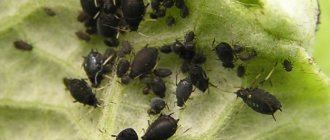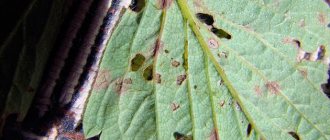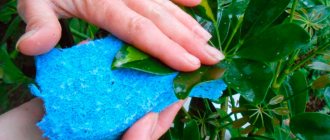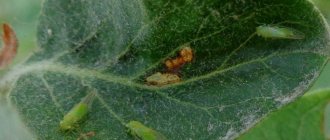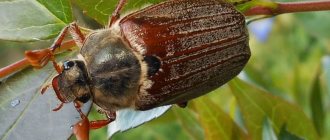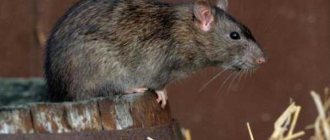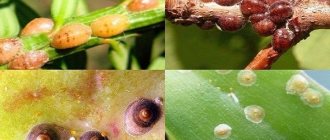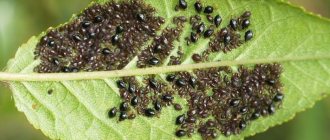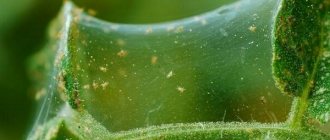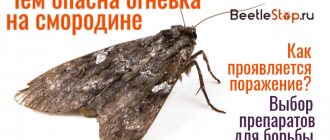Author: Elena N. https://floristics.info/ru/index.php?option=com_contact&view=contact&id=19 Category: Plant Pests Published: June 13, 2018Last edits: October 30, 2020
Moths (lat. Geometridae), or surveyors , are a large family of butterflies, numbering more than 2,000 genera and about 23,000 species. For garden and vegetable plants, the greatest danger is from moth caterpillars, which eat both cultivated and wild plants. Most often, in our climate, we find such representatives of the family as the pine and winter moths, the skinned moth and the gooseberry moth, or gooseberry.
Moth butterfly - description
The moth butterfly has a wingspan from 9.5 to 51 mm, but in most insects it reaches 30 mm. The body of butterflies is weak, the wings are wide and tender, although among moths there are species with both a thick body and underdeveloped wings. Moths have no eyes, the proboscis is weak and spiral, and the legs are thin. The front wings are usually broadly triangular, and the hind wings are rounded and pinched. Moths fly mainly at night; their flight is weak and uneven. At rest, the wings are most often spread flat or folded into a house. In males they are well developed and have a protective coloring, and the antennae in males are feathery. Many female moths have shortened wings or no wings at all, and thread-like antennae.
The moth caterpillar is most often naked, long, thin, worm-shaped, usually colored to match the color of the leaves, stems or bark. The two front pairs of legs of caterpillars are undeveloped, and because of this they crawl strangely, as if measuring space with their body, like a measuring chain, or a span - hence the name of this family. The moth larva has such developed muscles that it can stand on its hind legs for a long time, with its body extended: at these moments the caterpillars look like leaf petioles or broken twigs.
In the photo: Moth caterpillar
Smooth, without a cocoon, red-brown, gray, green or yellow pupae overwinter in cracks in the bark, in spider nests in trees, in the ground or on its surface. After emerging from the pupa until mating, adult moths are nocturnal and feed on flower nectar, but there are species that do not need food. After mating, females lay eggs on seed pods, buds, branches, leaves or needles. The caterpillars that hatch from the eggs feed very intensively and then pupate.
- Spider mites: how to fight, remedies and preparations
Moths are leaf-eating and pine-eating pests that eat the generative and vegetative organs of plants and can cause serious damage to fruit trees and shrubs over large areas. As a result of their pest activity, the quality of fruits deteriorates, crop yields decrease, and the winter hardiness of plants and resistance to other unfavorable factors are weakened. Moths are characterized by periodic outbreaks of mass reproduction, the consequences of which can last for several years, and during such periods moths can completely destroy leaves on plants.
Stages of the biological cycle
Individual adults begin to emerge towards the end of May. But massive replenishment of the population occurs in June-July. At the beginning of the first summer month, active mating occurs. The female then lays eggs. She places them on old needles in rows of up to three dozen pieces. There are usually 4-7 such rows. If the moth invasion is massive, then fresh, just emerging needles are used. On average, one female moth lays 80-230 eggs per season.
The egg develops in about 20 days. But in hot climates (+25C and above), this process is reduced to 8 days. The emerging caterpillars immediately begin to eat the needles with appetite. At first, they gnaw out longitudinal grooves, and as they grow, they jab the needles on both sides. The caterpillar does not touch the trunk and base. Adults eat the entire needles . During the period of its existence in caterpillar form, the moth destroys about 100 pieces of pine needles (about 3.5 kg).
Harmful insects carry out their destructive activities at night. First, last year's needles are used, then fresh needles. And so on until deep autumn. Only in October does the caterpillar burrow into the litter under a tree and pupate for the winter. With the arrival of warm weather (May-June), an adult individual emerges from the pupa and the cycle begins anew.
Types of moths
Pine moth , like all lepidopteran pests, has a protective coloring that makes it invisible against the background of pine bark: gray-brown wings are decorated with zigzags and black, white and dark brown spots. Green pine moth caterpillars feed on pine needles and, at the peak of their gluttony, can deplete entire hectares of young pines or fir trees.
The birch moth has changed its color over the past hundred years. This is due to the fact that the soot settling on birch trunks made their bark darker, so the birch moth butterfly learned to produce a black pigment: the outer side of its wings is covered with black spots, and the butterfly sitting on the birch practically merges with the trunk. Birch moth caterpillars are green. They feed on the leaves of not only birch, but also alder and hazel.
The black moth is a Eurasian forest species with a wingspan of 13-15 mm. Both the body and wings of the butterfly are black; a thin white border runs along the top of the front wings. The caterpillars of this species are velvety green; they prefer to feed on earth chestnuts and rosemary, although in the absence of these plants the pests may change their tastes.
The fir moth lives in the Far East and eastern Siberia. Its grayish wings are decorated with gray or white wavy lines. The fir moth caterpillar looks like a piece of a dry branch. The larvae usually feed on larch and fir needles.
Gooseberry moth , or gooseberry, has a bright color: on the back and head, yellow hairs and black spots form a T-shaped pattern, clearly visible on a white background, and lower on the wings there are large merging spots and black and yellow lines in a wavy line. The caterpillar of this moth, strewn with large dark spots, also has an elegant appearance. The caterpillar damages not only gooseberries, black and red currants, but also rosaceous plants: plum, apple, apricot. The caterpillar feeds on leaves, buds and seeds of berries, and glues the damaged areas with cobwebs and pupates in them.
- How to deal with bean pests
The winter moth looks discreet: there are dark transverse lines on its gray wings. Caterpillars of this species damage stone fruit and pome crops, as well as wild deciduous trees, eating out buds and young seeds from the inside. Eggs laid in autumn overwinter in cracks in the bark at temperatures down to -7 ˚C. For the winter moth to complete its cycle, low temperatures are necessary.
Ripped off - under this crude name there is a brown, cream or greenish butterfly, the wings of which are decorated with two wavy stripes. Its larvae damage the leaves, buds and buds of not only apple trees, cherry plums, rowan berries, cherries and blueberries, but also wild maples, birches, lindens, oaks and rose hips, leaving characteristic ragged bite marks on them.
In the photo: Moth butterfly
The great green moth is distinguished by its large size: its wingspan can reach 45-50 mm. Newly pupated butterflies are colored bright green, against which transverse white stripes are clearly visible. This species lives in forests throughout Europe, feeding mainly on the leaves of hazel and birch, but this does not mean that it is not dangerous for other deciduous species. The brown caterpillar of the green moth reaches a length of 25-30 cm. The insect overwinters underground and in cracks in the bark, and in the spring it acquires a green color with brown spots.
The mulberry moth is distributed mainly in Central Asia. The females of this species do not have wings, but the males have brownish-gray wings. Mulberry moth caterpillars eat the buds and leaves of mulberry, peach, apricot, quince, plum, apple, poplar and acacia trees.
Preventive measures
Like other conifers, cedars are susceptible to diseases that can damage them or cause death. And this does not depend on where the tree grows - in the forest or in the park. In addition, old, rotten or diseased cedar poses a potential danger to the safety of people in populated areas
For these reasons, it is important to take timely measures to prevent diseases
Factors influencing the health of cedars are:
- fungi that parasitize them;
- climatic conditions;
- planting site, including soil composition, watering.
It is difficult to accurately diagnose diseases. They can occur without visible symptoms - for example, infection of a tree with bark beetles or rotting of roots at the initial stage. Loss or discoloration of needles can be caused by stress from drought or flooding, damage from herbicides, mites, fungi
And this also becomes an important reason to start with prevention, without waiting until it is time to treat the tree.
Prevention includes:
- regular sanitary inspections of the condition of trees;
- planning plantings taking into account the condition of the soil and taking measures to improve it;
- managing the conditions in which cedar grows.
It is necessary to consider whether the site prepared for planting is susceptible to flooding, drought or soil compaction. If possible, you should eliminate the shortcomings, and then select varieties that can grow in your existing conditions.
When purchasing a seedling from a nursery, you need to find out what diseases a particular variety is susceptible to, the timing and conditions under which they appear.
This will allow you to plan a schedule for treating the tree with fungicides to prevent infection. It is also a good idea to check with your local gardening societies to see what diseases are common in your area. This will assist in identifying the problem and selecting the best strategy for chemical treatment.
If a diseased tree is discovered, you will need to assess the extent of the problem. In case of minor damage, it is necessary to remove the infected branches, treat the wound with a solution of Bordeaux mixture 1% and cover it with garden varnish.
Important! Tools used for work must be wiped with alcohol before and after pruning, so as not to transfer phytopathogens from diseased cedars to healthy ones. Pests and diseases can spread very quickly, so treatment should begin as soon as the first signs of a problem are noticed
Keep in mind that it needs to be done several times in order to destroy those insects that hatch later from the laid eggs. This will not only keep the cedars healthy, but will also support their immunity.
Pests and diseases can spread very quickly, so treatment should begin as soon as the first signs of a problem are noticed. Keep in mind that it needs to be done several times in order to destroy those insects that hatch later from the laid eggs. This will not only keep the cedars healthy, but will also support their immunity.
How to get rid of moth
Fighting the moth
It is necessary to combat moths using a combination of agrotechnical, mechanical, chemical and biological methods. Agrotechnical control methods include:
- regular inspection of plants for pests;
- loosening the soil in the trunk circles of trees and shrubs from early spring to the end of April, and then from the first ten days of September until the onset of frost;
- digging up the soil around trees in summer and autumn;
- mechanical removal of dead bark and moss from trees;
- whitewashing of trees in early March and October.
Mechanical control measures - the most labor-intensive, but also the safest - include:
- morning collection of caterpillars by hand or shaking them onto the litter and subsequent destruction;
- use of adhesive belts against insects;
- collection and destruction of spider nests on bushes and trees and plant debris in their tree trunks.
The chemical method involves treating fruit storage facilities, plants, and containers with pyrethroids, organophosphorus compounds and neonicotinoids. And the biological method of combating moths means attracting their natural enemies to the garden, which are ichneumon flies and tahina flies, for which phacelia, clover, ornamental onions and sunflowers are planted on the site, as well as spraying trees and shrubs with biological pesticides.
- Rodents: how to get rid of them and why they are dangerous
In the photo: Garden pest moth
Remedies for moths (drugs)
It is advisable to use insecticidal preparations against moths for preventive spraying of the garden in the spring. If there is a need to treat plants during the season, then in the case of even a very large number of pests, only preparations of biological origin are used. Preventive spraying of fruit trees and berry bushes is carried out before flowering begins. The following drugs are used for treatment:
- Akarin is an insectoacaricide, a biological preparation of contact-intestinal action, effective against a complex of pests;
- Karbofos is a broad-spectrum insecticide and acaricide belonging to the class of organophosphorus compounds and used for the rapid and complete destruction of sucking and leaf-eating insect pests;
- Zolon is a contact-intestinal insecticide and acaricide that remains highly effective even at low air temperatures. However, the drug is highly toxic to warm-blooded animals;
- Kinmiks is a contact-intestinal insecticide for the control of gnawing and sucking pests;
- Decis is a contact-intestinal insecticide, part of the group of synthetic peritroids and used to control sucking and leaf-eating pests;
- Fitoverm is an insectoacaricide of biological origin with enteric contact action to protect plants from pests in open and closed ground;
- Bitoxibacillin is a biological insectoacaricide for protecting plants from pests. The period for the last treatment with the drug is five days before harvesting any crops and 10 days before harvesting medicinal plants;
- Lepidocide is a highly effective insecticidal biological preparation with intestinal action that can be used at any stage of plant development;
- Dendrobacillin is an insecticide recommended for spraying plants during the growing season against leaf-boring and other pests. The last treatment period is five days before harvesting any crops and 10 days before harvesting medicinal plants.
Why do oak trees die? Diseases of oaks and their treatment.
Mature oak trees react extremely negatively to construction work carried out in the immediate vicinity, to changes in climatic and soil conditions (changes in temperature, compaction of roots - trampling, backfilling of roots with imported soil or soil from a pit, stagnant waterlogging of soils). Unfortunately, even if you treat trees with care and prevent them from being damaged by humans, it is impossible to protect plants from climate change. Weakened trees are susceptible to pest attacks. Currently, the main threat to oak trees is the oak budworm, an outbreak of which began in 2012 and had not yet reached its peak by 2016. Outbreaks of this pest are characterized by a protracted course, up to 6-8 years. Oak effectively resists attacks from leaf-eating insects, since it is capable of compensating for the lost crown by producing new leaves to replace those eaten by pests. However, any insect attacks, even the most insignificant ones, undermine the protective powers of the trees. Subsequently, oak trees often become ill with powdery mildew, bacterial dropsy, and chronic diseases become aggravated. It is pests that provoke these pathological processes.
Signs of weakening oak can be easily determined by visually assessing the condition of the crown. In the crown, drying or dry branches of the second and subsequent orders will be noticeable; even dying large skeletal branches can be found. The foliage of weakened trees is paler and smaller than that of healthy ones, and starting from mid-June, the first signs of powdery mildew and (or) bacteriosis can already be noted in the crown (white and brown spots on the leaves, curling of leaves, drying out of young shoots).
Treatment of oak trees should be aimed at eliminating the causes that caused their weakening and at combating diseases and pests. If trees suffer from bacterial dropsy, measures to improve soil health are required; if necessary, work is carried out to clean artificially filled or chemically poisoned soil and eliminate stagnant waterlogging. Antibacterial treatment is carried out - spilling the soil with antibiotics, intra-stem injections, spraying. If drying out of oak trees due to powdery mildew is observed, then treatment is carried out with fungicidal (antifungal) drugs.
If the tree has been attacked by pests, then spray with insecticidal or biological preparations, and injections also give good results. When carrying out work on the treatment and protection of oak trees, it is necessary to take into account that insects are often carriers of all kinds of diseases. And if a tree is attacked by insects in May, then by mid-summer, as a rule, consequences arise - the first manifestations of disease. And by the end of summer, oak trees that are not cured in time will be significantly behind in growth and will lose their foliage earlier than healthy ones. The risk of mass pest attacks next year increases significantly. Therefore, when treating oak against leaf rollers and other insects, antiseptic and fungicidal preparations are added to the mixture to prevent diseases that are likely to occur in the attacked tree.
Fighting moth with folk remedies
Chemicals are the most powerful weapon against any pest, but they contain poisons that can accumulate in fruits. If the pest situation does not look threatening, then it is better not to use potent insecticides, but to make do with time-tested folk remedies. The effectiveness of herbal decoctions and infusions compared to the effect of pesticides does not exceed 30-40%, and you may have to carry out several treatments instead of one, but as a result you will not only destroy moths, but also preserve the quality of the fruit. The following folk remedies are used to control pests:
- decoction of tomato tops: infuse 1 kg of chopped tomato tops in 10 liters of water for 4-5 hours, then boil the infusion over low heat for 2-3 hours, let it cool, strain and add the same amount of water;
- infusion of burdock leaves: crushed leaves are placed in a bucket, filling it to a third of its volume, water is added to the brim and infused for three days, after which it is filtered and used to treat plants;
- milkweed decoction: 4 kg of crushed stems of milkweed need to be poured into 5 liters of water, boiled for 2.5-3 hours, cooled, strained and topped up with water. This amount is enough for two sprayings, the first of which is carried out as soon as the caterpillars are detected, and the second - 4 days after the first;
- decoction of hot pepper: 100 g of finely chopped bitter pepper fruits should be poured into 1 liter of water, boil for an hour, then leave for two days, then crush the pepper into a pulp directly in the decoction, strain the mixture and use in parts, adding half a glass of decoction to 10 liters of water. For better adhesion, you need to pour 50 g of liquid soap into the solution;
- wormwood decoction: boil 1 kg of wilted wormwood in 2 liters of water for 10-15 minutes, let the decoction cool, strain and add enough water to make 10 liters. Use for weekly treatments;
- yarrow infusion: 800 g of dried herb collected during flowering, steam with boiling water, leave for 30-40 minutes, then add water to make 10 liters and leave for another 40 minutes. Before processing the plants, filter the infusion and add 50 ml of liquid soap to it;
- tansy powder: grind dry tansy stems, flowers and leaves into powder and dust the plants with it.
Fruit mites
Fruit mites mainly reproduce in the summer, at times when pyrethroid preparations are used as an insecticide. The most common is the red fruit mite. It is an insect measuring 0.4 mm, first red, then red-brown in color. During the month of her life, the female lays up to a hundred red spherical eggs with radial ribbing and a thin stalk at the top. Over the summer, the red fruit mite can produce from 4 to 8 generations. Eggs of the summer generation are mainly laid along the leaf veins, on its underside. Closer to winter, females lay eggs in the periphery of the crown on young shoots. The eggs overwinter on the surface of the rough bark. When a tree is severely damaged, the bark appears reddish-brown.
After overwintering before the flowering of apple orchards, the eggs hatch into larvae, which through the nymph stage turn into an adult insect. After a week, the red fruit mite is already capable of reproducing.
Through their sucking mouthparts, mites suck out the juices from the leaves, causing the foliage to dry out and fall off. Plums shrink and become small. With massive infection, a third of the crop may be lost.
In case of infection of a plum orchard with red fruit mite, avoid the use of pyrethroid drugs. At the moment of maximum hatching of larvae, insectocaricides are used: fufanon, danadim, fitoverm, etc. For mass reproduction of mites, specific preparations are used, such as sunmite, neoron, nissoran, apollo, demitan, omaite, etc.
Prevention of moths
To prevent the moth from ruining your harvest, you need to start fighting it in the fall: collect fallen leaves under the plants and burn them, then dig up the soil in the trunk circles of bushes and trees. From the beginning of the season, carry out two preventive treatments of the garden with a solution of Karbofos or another preparation of a similar effect: the first - before the buds begin to bloom, the second - after flowering. When fruits appear on the plant, it is advisable to carry out treatments only with folk remedies.
Timely care of plants can also be considered as a preventive measure against moths, since all gardeners know that pests do not parasitize healthy and strong plants. Therefore, take care of your garden, keep the soil in the tree trunks clean, destroy weeds in a timely manner, water and feed trees and shrubs, and then you will not have to fight pests.
What about the willow? Spots on leaves
1. Before the buds open, you need to treat the trees with a 2-3% solution of Bordeaux mixture. Repeat treatment with a 1% solution during budding and after flowering. 2. In the same phases, treat the first time with 1% copper sulfate (blue spraying), the second time with copper oxychloride, or ordan, oxychome. You can use the drug Abiga-Pik. The third spraying is carried out with cuprosil or 1% Bordeaux mixture. Some gardeners recommend repeating spraying with 1% Bordeaux mixture after 10-12 days. 3. The chemical fungicide topaz is effective against rust.
. Three times treatment is enough to protect against rust. Treatments begin in the bud breaking phase, immediately after flowering and in the fruit growth phase (if it is a fruit tree).
Biological products can also be used
: trichodermin, planriz, phytosporin-M, gamair (bactericide), phytodoctor, gaupsin. The latter drug stands out for its dual action. It not only destroys fungal diseases, but also a number of pests.
And, finally: if you have juniper growing on your site (or your neighbors), then carefully inspect and treat it at the same time, because He is the conductor of this disease. Rust also loves to “attack” pears.
Evolution of color or type of adaptation
The birch moth is capable of changing its color. The acquisition of this feature was influenced by external factors caused by human activity. The process of natural selection that caused the appearance of dark coloration is called industrial melanism.
Until the middle years of the 19th century, insects had white wings with black spots. Using this color scheme, butterflies were perfectly camouflaged on birch bark. They could also hide in lichens and enemies would not notice them. Later, colonies of moths of the same color began to appear near the large industrial centers of Europe and North America. The pests changed their main color to black.
REFERENCE: In areas without developed industrialization, the color of butterflies remains light. There is also an intermediate species of butterflies that live in the border strip of industrial areas; their color is gray with a black pattern.
Bapta temerata
| Synonyms | Birch moth, entire birch moth, entire birch moth |
| In English | Bapta temerata |
| Class | Insects – Insecta |
| Squad | Lepidoptera (Butterflies) – Lepidoptera |
| Family | Moths – geometridae |
| Biological group | Pests of stone fruit crops; Pests of fruit and pome crops; Pests of fruit crops; Forest pests; Pests of ornamental crops; Pests of urban green spaces |
| Special marks | Common type |
| The entire birch moth is a pest of apple, cherry, and plum trees. In addition, it harms beech, oak, willows, birch, maple, roses and thorns by eating leaves. Reproduction is bisexual. The pupa overwinters in a dense compact cocoon in the soil. One generation of the pest develops per year. | |
| Summary data | |
| Fertility (pcs) | 100 |
| Generations per year | 1 |
| Egg(mm) | length 0.61-0.69 mm width 0.4-0.5 mm |
| Larva (mm) | 20-25 |
| Pupa (mm) | 9,8-10,5 |
| Wingspan (mm) | 22-25 |
